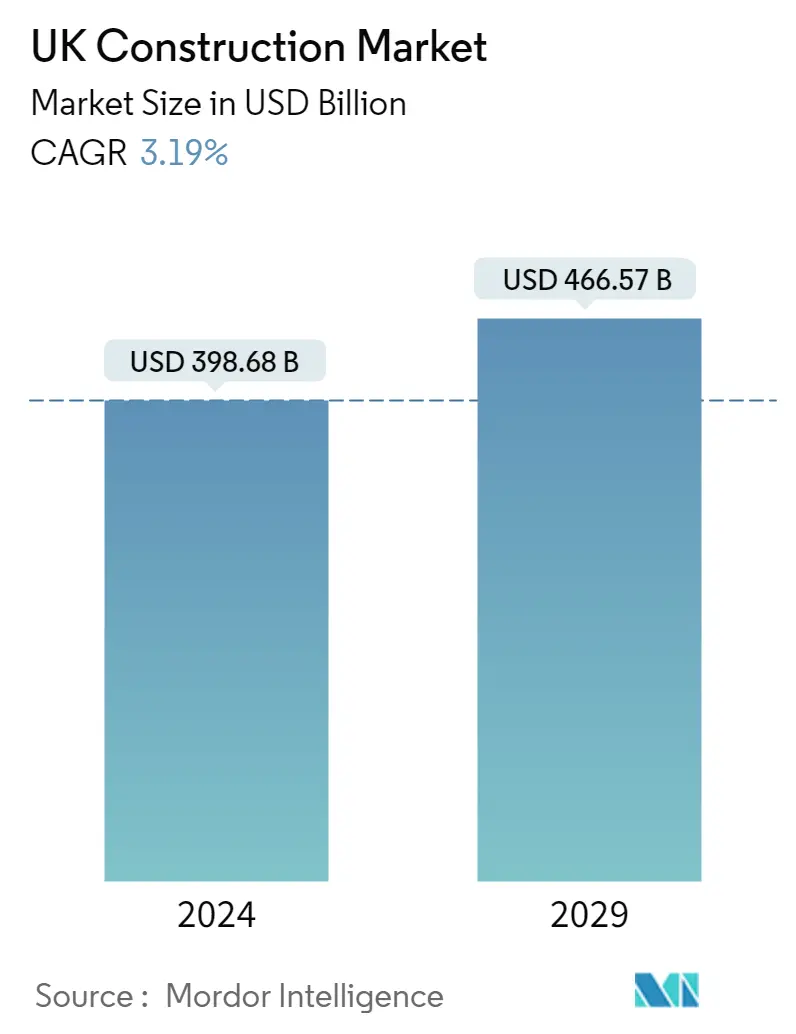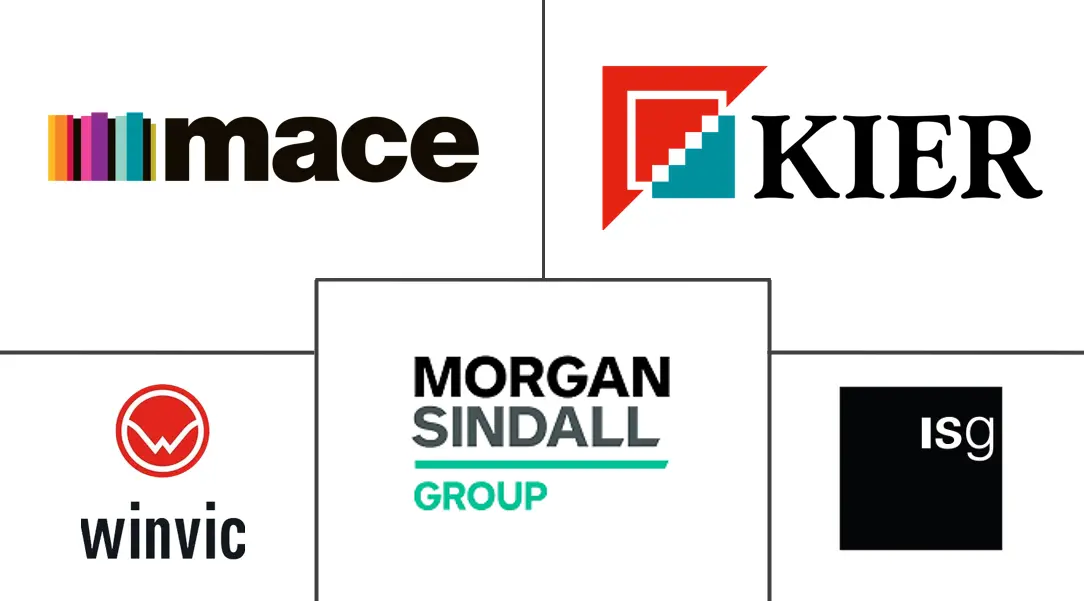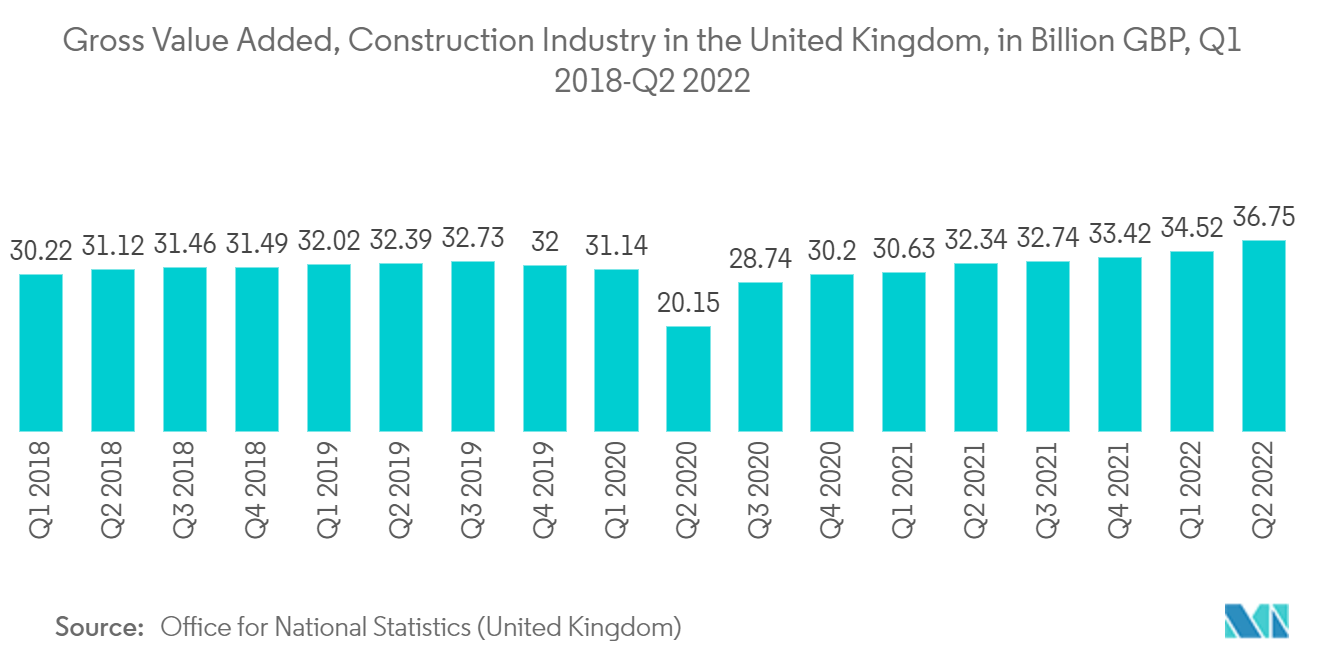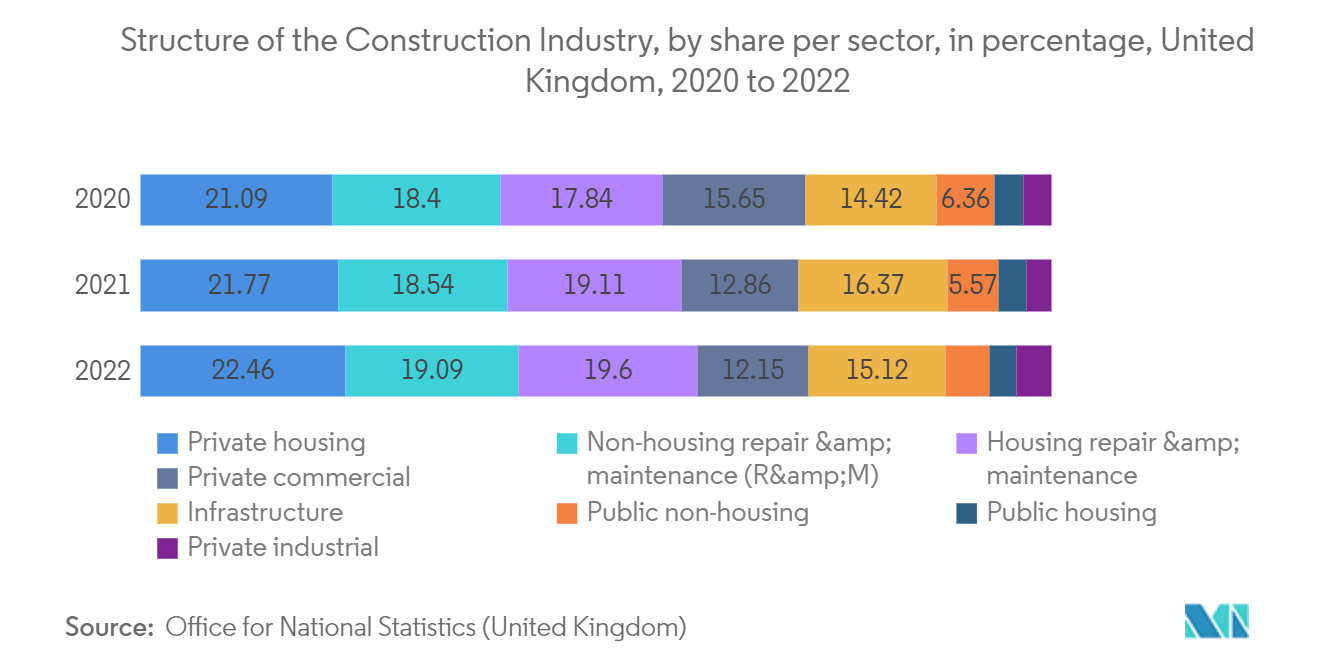UK Construction Market Size

| Study Period | 2020 - 2029 |
| Base Year For Estimation | 2023 |
| Market Size (2024) | USD 398.68 Billion |
| Market Size (2029) | USD 466.57 Billion |
| CAGR (2024 - 2029) | 3.19 % |
| Market Concentration | Medium |
Major Players
*Disclaimer: Major Players sorted in no particular order |
UK Construction Market Analysis
The UK Construction Market size is estimated at USD 398.68 billion in 2024, and is expected to reach USD 466.57 billion by 2029, growing at a CAGR of 3.19% during the forecast period (2024-2029).
The increasing building activities in the country drive the market. Furthermore, the market is driven by the growing commercial activities in the country.
- Due to the strict execution of the measures to restrict the disease's spread, the COVID-19 pandemic negatively impacted the UK construction industry in 2020, with overall output decreasing by almost 46% year over year in April 2020. However, there has also been a significant recovery, with positive growth rates in the UK's construction output every month since March 2021. The gross value added by building activities in the UK returned to pre-pandemic levels in the third quarter of 2021 and continued to increase. For instance, compared to 2020, more new homes were registered to be built in 2021 in every region outside London, with growth rates in the North East, East Midlands, and Eastern regions reaching above 45%. Infrastructure construction had the biggest market share growth in the sector.
- Even though the general trends point to significant expansion, the UK construction industry has recently faced numerous difficulties. Inflation and Russia's invasion of Ukraine further disrupted the supply chain and drove up the price of building materials, in addition to the COVID-19 outbreak. For instance, rising energy and oil prices impacted steel production, which requires a lot of energy. Concrete reinforcing bars, also composed of steel, cost 45.8% more in March 2022 than in March 2021. The cost of transporting other construction supplies has increased due to the rising price of oil, driving up the overall cost of most construction materials.
- At the start of 2021, the value of new warehouse construction orders rose significantly, reaching a peak. In the second quarter of 2022, warehouse construction orders were worth 1.4 billion British pounds. The value of new construction orders for public buildings in the health sector in Great Britain amounted to 561 million British pounds in the second quarter of 2022. In the first half of 2022, roads and railways were the infrastructure types with the highest output value in Great Britain. On the other side of the spectrum, water and sewerage construction had the lowest output values, under 165 million British pounds in 2022, according data from the to Office for National Statistics (United Kingdata.
UK Construction Market Trends
Increase in GVA of construction Industry
- Construction is a sector where the UK has a strong competitive edge. The UK has world-class architecture, design, and engineering expertise, and British companies are leading the way in sustainable construction solutions.
- Changes in the international economy are creating new opportunities for Britain. To help boost economic recovery, the government is doing all it can to help British businesses grow and have the aspiration, confidence, and drive to compete in the global market. This includes reforming the planning system, ensuring funding is available for crucial infrastructure projects, and supporting the housing market through critical initiatives such as the Help-to-Buy Equity Loan Scheme and the Funding for Lending Scheme.
- The gross value added (GVA) to the construction sector in the United Kingdom in the second quarter of 2022 was more than four billion British pounds higher than in the corresponding period of 2021, according to the Office for National Statistics (United Kingdom). The GVA of this sector dropped to GBP 20 billion (USD 25.6 billion) in the second quarter of 2020 due to the COVID-19 pandemic, marking the sector's lowest point in a decade. Out of all the subsectors in the United Kingdom construction industry, private housing was the one that made the most money.

Private Housing Share is the Highest in the United Kingdom Construction Industry
- Private housing was the most significant sector within the construction industry. Nevertheless, housing and non-housing repair and maintenance together amounted to almost 39 percent of the construction output in 2022, according to Office for National Statistics (United Kingdom) data. The output volume of infrastructure grew during the past years, surpassing the construction of commercial buildings.
- The number of households occupied by private renters in England has increased gradually since 2000. From two million in 2000, households reached 4.61 million in 2022. The private housing sector was forecast to see further growth in the current year. That industry segment was expected to grow between three and five percent annually in the coming years. The average price of houses in the United Kingdom has also been increasing significantly.
- According to the Office for National Statistics (United Kingdom), private rental prices paid by tenants in the UK rose by 4.4% in the 12 months to January 2023, up from 4.2% in the 12 months to December 2022. Annual private rental prices increased by 4.3% in England, 3.9% in Wales, and 4.5% in Scotland from 12 months to January 2023. In England, the East Midlands saw the highest annual percentage change in private rental prices from 12 months to January 2023 (5.0%), while the West Midlands saw the lowest (3.9%). London's annual percentage change in private rental prices was 4.3% in the 12 months leading up to January 2023.

UK Construction Industry Overview
The United Kingdom Construction Market is partially fragmented, with many regional and local players and a few global companies. Furthermore, the residential and transport construction sectors have a huge potential for growth in the forecasted period, stimulating opportunities for other market players. The major players include Kier Group plc, Morgan Sindall Group plc, Mace Ltd, Winvic Group and ISG plc. Further, the market is expected to grow during the forecast period due to increased construction investments and upcoming major projects in the United Kingdom.
UK Construction Market Leaders
-
Kier Group plc
-
Morgan Sindall Group plc
-
Mace Ltd
-
Winvic Group
-
ISG plc
*Disclaimer: Major Players sorted in no particular order

UK Construction Market News
- December 2022: The Access Group has announced that it has successfully acquired Construction Industry Solutions (COINS), enhancing its capacity to offer international software and services to businesses engaged in the construction industry.
- March 2023: The Department of Transport, UK, has announced over £40 billion of capital investment in transport across the next two financial years, which will drive significant improvements to rail and roads across our country.
UK Construction Market Report - Table of Contents
1. INTRODUCTION
- 1.1 Study Assumptions and Market Definition
- 1.2 Scope of the Study
2. RESEARCH METHODOLOGY
3. EXECUTIVE SUMMARY
4. MARKET DYNAMICS
- 4.1 Market Overview
-
4.2 Drivers
- 4.2.1 Transport Infrstructure Investment
-
4.3 Restraints
- 4.3.1 Shortage of Skilled Labor
-
4.4 Opportunities
- 4.4.1 The Birmingham Big City Plan
- 4.5 Value Chain / Supply Chain Analysis
-
4.6 Industry Attractiveness - Porter's Five Forces Analysis
- 4.6.1 Bargaining Power of Suppliers
- 4.6.2 Bargaining Power of Buyers/Consumers
- 4.6.3 Threat of New Entrants
- 4.6.4 Threat of Substitute Products
- 4.6.5 Intensity of Competitive Rivalry
5. MARKET INSIGHTS
- 5.1 Current Economic and Construction Market Scenario
- 5.2 Technological Innovations in the Construction Sector
- 5.3 Impact of Government Regulations and Initiatives on the Industry
- 5.4 Insights on Upcoming and Ongoing Infrastructure Projects in United Kingdom
- 5.5 Impact of Covid-19 on the Market
6. MARKET SEGMENTATION
-
6.1 By Sector
- 6.1.1 Residential
- 6.1.2 Commercial
- 6.1.3 Industrial
- 6.1.4 Infrastruture
- 6.1.5 Energy and Utilities
-
6.2 By Key Regions
- 6.2.1 England
- 6.2.2 Northern Ireland
- 6.2.3 Scotland
- 6.2.4 Wales
7. COMPETITIVE LANDSCAPE
-
7.1 Company Profiles
- 7.1.1 Kier Group plc
- 7.1.2 Morgan Sindall Group plc
- 7.1.3 Mace Ltd
- 7.1.4 Winvic Group
- 7.1.5 ISG plc
- 7.1.6 Bouygues UK
- 7.1.7 Balfour Beatty plc
- 7.1.8 Galliford Try plc
- 7.1.9 Keller Group plc
- 7.1.10 Laing O'Rourke plc*
- *List Not Exhaustive
8. FUTURE OF THE MARKET
9. APPENDIX
** Subject To AvailablityUK Construction Industry Segmentation
Construction is the installation, maintenance, and repair of buildings and other stationary structures, as well as the construction of roadways and service facilities that form fundamental components of structures and are required for their operation. Construction encompasses the processes involved in constructing buildings, infrastructure, industrial facilities, and related operations from start to finish. A complete background analysis of the United Kingdom Construction Market, including the assessment of the economy and contribution of sectors in the economy, a market overview, market size estimation for critical segments, emerging trends in the market segments, market dynamics and geographical trends, and COVID-19 impact, is covered in the report.
The United Kingdom construction market is segmented by sector (commercial construction, residential construction, industrial construction, infrastructure construction, and energy and utility construction) and key regions (England, Northern Ireland, Scotland, and Wales). The report offers market size and forecasts in value (USD) for all the above segments.
| By Sector | Residential |
| Commercial | |
| Industrial | |
| Infrastruture | |
| Energy and Utilities | |
| By Key Regions | England |
| Northern Ireland | |
| Scotland | |
| Wales |
UK Construction Market Research Faqs
How big is the UK Construction Market?
The UK Construction Market size is expected to reach USD 398.68 billion in 2024 and grow at a CAGR of 3.19% to reach USD 466.57 billion by 2029.
What is the current UK Construction Market size?
In 2024, the UK Construction Market size is expected to reach USD 398.68 billion.
Who are the key players in UK Construction Market?
Kier Group plc, Morgan Sindall Group plc, Mace Ltd, Winvic Group and ISG plc are the major companies operating in the UK Construction Market.
What years does this UK Construction Market cover, and what was the market size in 2023?
In 2023, the UK Construction Market size was estimated at USD 386.36 billion. The report covers the UK Construction Market historical market size for years: 2020, 2021, 2022 and 2023. The report also forecasts the UK Construction Market size for years: 2024, 2025, 2026, 2027, 2028 and 2029.
What are the future growth prospects for the UK Construction Market?
The future growth prospects for the UK Construction Market are a) Increasing emphasis on sustainability and integration of green building practices b) Growing focus on private sector sustainability initiatives and advancements in construction technology c) Surging focus on energy-efficient and sustainable construction
UK Construction Industry Report
The UK construction industry is on a trajectory of significant growth and transformation, fueled by a steadfast commitment to sustainability, cutting-edge technological advancements, and a surging demand for both residential and commercial infrastructure. In sync with global movements towards energy efficiency and the adoption of smart building technologies, the UK construction market is experiencing an uptick in investments directed towards green building practices, Building Information Modeling (BIM), and the Internet of Things (IoT) applications. Spanning a diverse range of construction types, including residential, commercial, and industrial projects, the market is distinctly focused on sustainable and energy-efficient development. UK construction companies are increasingly gravitating towards eco-friendly materials and renewable energy systems, underscoring their commitment to environmental preservation. The market growth is propelled by the strategic leverage of technological innovations to boost efficiency and sustainability. With construction industry UK statistics projecting a promising future, the sector's advancement is well-documented in Mordor Intelligence™ Industry Reports, offering a comprehensive market forecast outlook and historical overview. For a deeper dive into this burgeoning market, a free report PDF download is available, providing valuable insights into the UK Construction market share, size, and revenue growth rate.



